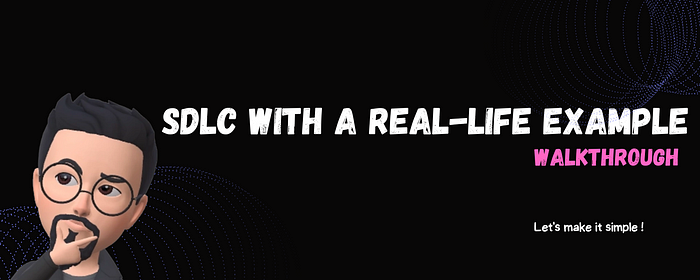SDLC with a Real-Life Example

SDLC stands for Software Development Life Cycle. It is a process that outlines the various stages that software goes through from conception to retirement. These stages typically include planning, requirement gathering, design, development, testing, deployment, and maintenance. The purpose of SDLC is to ensure that software is developed in a systematic and disciplined way, with quality and efficiency in mind, and to minimize the risk of errors or defects.
Let’s say a company wants to develop a new mobile app that allows users to order food from local restaurants for delivery. Here’s how the SDLC might be applied to this project:
Phase 1: Planning
- The project team defines the project scope: developing a mobile app for food ordering and delivery.
- They identify stakeholders, including the company, users, and restaurants.
- They establish timelines, budgets, and resources required for the project.
Phase 2: Requirements Gathering
- The project team works with stakeholders to define the system requirements: the app must allow users to browse menus, place orders, and track delivery.
- They document functional and non-functional requirements, such as the need for a user-friendly interface and secure payment processing.
Phase 3: Design
- The project team creates a detailed design document outlining the app’s structure, components, and interfaces.
- They specify the app’s features, such as a search bar, menu categories, and cart functionality.
- They define the app’s architecture and how it will integrate with external systems, such as payment processors.
Phase 4: Development
- The project team begins coding the app, following the design document.
- They use programming languages such as Swift and Java to build the app’s functionality, such as the ordering and payment processing systems.
- They continuously test and debug the app to ensure it meets the design document’s specifications.
Phase 5: Testing
- The project team tests the app for defects, bugs, and errors.
- They use various testing techniques, such as unit testing and system testing, to ensure the app is reliable, functional, and meets the requirements specified in the design phase.
Phase 6: Deployment
- The project team releases the app into the production environment, such as the Apple App Store or Google Play.
- They install, configure, and optimize the app to ensure it functions correctly on users’ devices.
- They provide training and support to end-users to ensure the app runs smoothly.
Phase 7: Maintenance
- The project team monitors the app’s performance and makes changes or updates as necessary to ensure it continues to function correctly.
- They may release bug fixes, updates, and improvements to the app to address user feedback and enhance functionality.
By following the SDLC, the project team can ensure the mobile app meets the project’s requirements and stakeholders’ needs, is reliable and functional, and provides a user-friendly experience for ordering food delivery.
